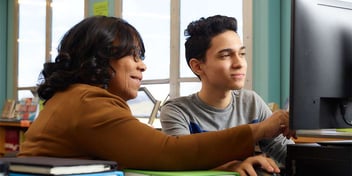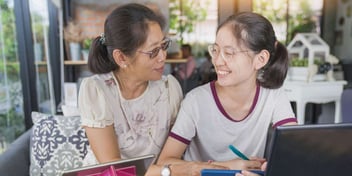For many, pandemic learning was the worst of remote learning
There was a time when I thought it would be great if everyone was aware of online learning and the impact it can have. How quality online learning gives students access to programs they need and want that are not available to them locally. Fast forward to 2020, and schools are forced to find the quickest emergency remote solution possible and implement it in a day! Because so many had bad experiences with the emergency remote solutions schools were forced to put in place, most people think they know what remote learning (and online learning as a whole) looks like. As a result, I spend much of my time explaining that what folks have seen over the past 18 months was not designed to foster a collaborative online classroom environment. There is a huge difference in the teaching and learning experiences when the curriculum is designed, and technology used to create a true virtual community for students and teachers.
We all know students and teachers who’ve used emergency remote learning over the past year. There have been mixed results. Some students had trouble finding quiet, uninterrupted learning from home, some were not engaged and fell behind, and some teachers had difficulties with this emergency education model, despite the best efforts of schools and educators. Several months into the 2020-21 school year, a survey suggested that many educators were still struggling to teach students online, Education Week reports.
What’s most frustrating to me is that I know a type of distance education that works well, because I’ve lived it and breathed, it, for more than twenty years. Back then, our goal at VHS, Inc. (now VHS Learning) was to discover if online learning could provide high school students regardless of their economic circumstance or geography, with equal access to education programs that prepare them for careers, college, and life. (Hint: yes it can!). Now, more than 700 high schools use the VHS Learning program to help provide expert training to local teachers, give their students access to a teacher-led, engaging, small online classroom experience, and help their students interact with their peers worldwide, taking subjects in all disciplines.
One of the best things about the VHS Learning program is that it is turnkey and has been tested by thousands of schools and students; it is not an emergency quick fix, and yet students can work entirely remotely. Schools using the program immediately expand their local offerings by more than 250 courses, including 24 AP courses and lots of electives including computer science and lab science courses. And the great thing? The program is teacher-led and students can fit their VHS Learning online class any time within their local school class schedule. Students work at the time that’s best for them, and they still interact with one another. This is not self-paced learning! This is a cohort of students learning with and from one other and with their teacher. They work together so they don’t fall behind. Group projects, class discussions, debates, lessons. All there.
Emergency remote learning, which is what we’ve seen during the pandemic, should not be confused with true online learning that is designed from the start to use online teaching best practices. We know what quality online experiences look like because our team helped develop the original online learning standards, and updated them in 2019. Emergency remote learning typically uses a “lecture model” that attempts to duplicate a teacher’s face-to-face teaching (think of students listening to their teacher talk over Zoom). Students can tune out just as if they were sitting in the back of a physical classroom. This Zoom model means students must attend class at the same time, which limits flexibility. In contrast, high-quality online learning by design puts students at the center of the learning process. Instead of sitting in front of a computer at a designated time for six hours a day, students have the freedom to work on assignments, participate in group projects, and contribute to class discussions at any time, if they meet due dates for assignments and keep up with the flow of the class. Students complete authentic, hands-on projects such as designing an island nation with its own system of government in VHS Learning’s AP® Government class.
Students who were already taking VHS Learning online courses through their local schools prior to the pandemic were lucky. Their learning was able to continue seamlessly using the tools already in place in this well-established program. The results speak for themselves. VHS Learning student scores on AP® exams have exceeded national averages for over a decade, including last year.
Quality online learning brings educational equity and benefits to students and expands the important learning taking place locally. It provides opportunities that would not otherwise be available to many students. It is not emergency remote learning, it’s carefully-crafted learning best practices – that just happen to take place remotely. By using an established nonprofit program like VHS Learning, teachers have the training they need, and schools and students have the courses and flexibility they want. A robust online learning program takes time but when done right, schools, teachers, students, and families benefit.


